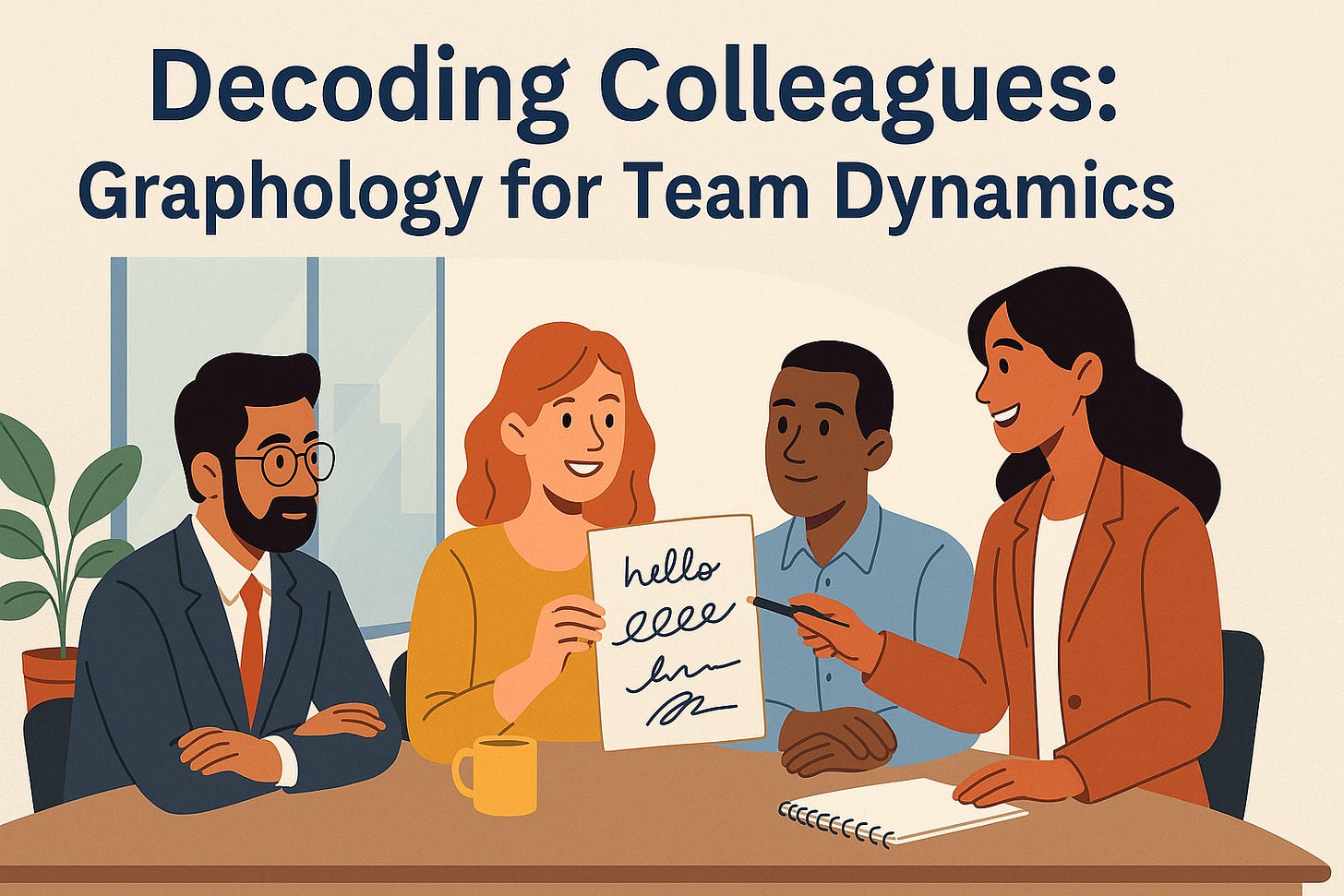Decoding Colleagues: Graphology for Team Dynamics
Unlock hidden communication styles, boost collaboration, and turn office conflicts into harmony—one pen stroke at a time.
Dear Readers,
Ever felt like your team meetings are a cacophony of crossed wires? What if you could glance at a colleague’s handwriting and instantly know whether they’re a cool-headed peacemaker or a fiery idea-generator? As Shantala D Kanth of Best Hand Creations, I’ve spent years studying the secret language of pen and paper. Today, let’s explore how graphology can transform your workplace—helping managers compose dream teams, easing tensions, and uncovering hidden talents in the ranks.
What Is Graphology in the Workplace?
At its core, graphology is the analysis of handwriting to reveal personality traits—communication style, emotional intensity, and leadership tendencies—long used by HR professionals to foster better team compatibility. Think of it as adding a psychological X‑ray to your recruitment and team-building toolkit.
Identifying Communication Styles
Every team member “talks” differently on paper:
Direct Writers: Straight‑forward slants and clear spacing show people who speak up and tackle issues head‑on.
Diplomatic Scribblers: Gentle curves and balanced margins signal those who value harmony over harsh feedback.
Reserved Stylists: Tight, small letters may hint at introverts who need time to gather thoughts before speaking.
By mapping these styles, leaders can pair a candid “firebrand” with a diplomatic “bridge‑builder,” ensuring conversations don’t blow up into conflicts.
“Every pen stroke is a peek into a colleague’s soul—read carefully and you’ll never be caught off guard.”
– Shantala D Kanth
Spotting Stress and Conflict Triggers
Just as storm clouds gather before a downpour, handwriting reveals tension:
Heavy Pressure: May indicate a team member under pressure, at risk of burnout or sudden outbursts.
Jagged, Erratic Lines: Could point to frustration—perhaps a project timeline needs adjusting.
Crowded Words: Suggest a mind racing with too many tasks at once.
Imagine handwriting as a pressure gauge on your office boiler. By monitoring these “ink warnings,” managers can intervene early—redistributing workloads or offering support—before small flare‑ups become full‑blown clashes.
Unearthing Hidden Talents
Graphology doesn’t just detect stress; it spots strengths:
Flourishes and Embellishments: Often signal creative thinkers who can spark innovation.
Confident, Upright Letters: Reflect individuals with leadership potential who inspire others with clarity and conviction.
Even, Steady Baselines: Mark those with rock‑solid reliability—your go‑to for dependable project delivery.
Think of your office as an orchestra: some colleagues are virtuoso soloists, others keep the rhythm steady, while a few compose the next big movement. Handwriting analysis helps you assign the right roles so the performance never misses a beat.
Indian Insights: From Bengaluru to Mumbai
In India’s fast‑paced tech hubs, I’ve observed coders scribbling jagged, rushed notes during crunch time—an ink‑blot cry for a breather. Conversely, at a Mumbai creative agency, designers’ scripts flow like the monsoon breeze—evidence of a nurturing culture that values expression over rigid deadlines.
Even HR teams at a Delhi-based startup use quick handwriting quizzes during onboarding to gauge comfort levels and preferred feedback styles—helping mentors tailor their approach from day one The Times of India.
Analogy 1: Handwriting as a Roadmap
Imagine each signature as a GPS route. Sharp turns and sudden stops reveal areas where your colleague might hesitate under pressure, while open highways suggest confidence in forging ahead. Use this map to chart collaborative journeys that avoid tumbleweeds and potholes.
Analogy 2: Ink as Emotional Weather
Just like meteorologists predict storms by watching wind patterns, supervisors can forecast team morale by observing handwriting “clouds”—heavy pressure or scattered spacing warning of an emotional thunderstorm on the horizon.
A Dash of Humor
Picture your office’s top negotiator doodling little smiley faces in their notes—are they secretly plotting world peace or just avoiding a tedious report? 😄 Handwriting quirks keep us humble reminders that behind every corporate title is a person with unique, sometimes hilarious, habits.
Practical Steps to Get Started
Collect Samples Ethically: Ask volunteers to take a short, fun handwriting quiz—no surprise audits!
Partner with a Graphologist: Bring in an expert (like yours truly!) to analyze and interpret the results.
Share Insights Constructively: Present findings in a supportive workshop—emphasize strengths before addressing areas for growth.
Measure Impact: Track team performance and morale pre‑ and post‑analysis to quantify the benefits.
Book Recommendation:
Read my book : Handwriting UNREVEALED: The Secrets of Handwriting Analysis for Personal and Professional Development Through Graphology
Link :
Reader Success Stories:
Do you want to get Expert Insights and Additional Resources to change your Life, Checkout our Premium Membership:
Follow me on Social Media:
Sign Off
Transforming team dynamics doesn’t require high‑tech gadgets—sometimes, all you need is an old‑fashioned pen and paper. By decoding the ink‑stained secrets of your colleagues, you’ll build a workplace that’s not only more productive but also more human.
Warm regards and ever-curious in ink,
Shantala D Kanth
Graphologist & Founder, Best Hand Creations
PS: Fancy a deeper dive? Subscribe on Substack for exclusive case studies, insider tips, and free handwriting quizzes—because great teams start with a single stroke!






